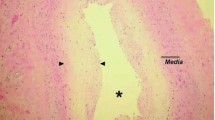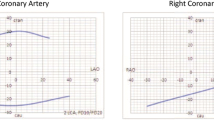Abstract
Little data exist to identify pediatric patients who have developed transplant coronary artery vasculopathy (CAV). Transplant patients do not exhibit the usual signs of coronary disease, making diagnosis more difficult. The aim of this study is to assess the use of myocardial perfusion imaging to identify CAV in transplant patients and to derive an incidence of occurrence. We studied pediatric cardiac transplant recipients who have undergone myocardial perfusion imaging on a routine basis. All patients from September 1999 through November 2004 with nuclear perfusion scans were included. Twenty patients age 7–24 years (mean: 12.7), 11 male and 9 female, were studied by SPECT technetium 99M tetrofosmin imaging. Sixteen of the 20 patients were studied based on a newly instituted protocol for surveillance. Transplant was 1–14 years (mean: 7.9) earlier. Patients were also studied by stress echocardiography. Six of 20 patients (30%) had a positive perfusion scan. Ages ranged from 8 to 18 years (mean: 12). Time from transplant to positive scans ranged from 1 to 9 years (mean: 5.6). One patient showed the same perfusion defect as 2 years earlier. Five patients with positive nuclear perfusion scans showed the abnormality on the initial study; one had a previous negative study 6 months earlier. Four patients who demonstrated ischemia with exercise showed resolution at rest; the other two had no resting study. Five of these six patients with abnormal perfusion scans had negative stress echocardiograms. Only one patient identified with coronary involvement reported symptoms (exertional dyspnea). Hypertension and rejection episodes were similar in all patients and in those with positive nuclear scans. Of the six patients with positive nuclear perfusion scans, two demonstrated coronary disease at cardiac catheterization. Two patients with coronary disease at catheterization had normal nuclear perfusion scans; one of two had a normal stress echo. When three imaging modalities were used, the incidence of CAV was 30%.
Symptoms in pediatric patients with CAV are seldom reported. Unfortunately, coronary arteriopathy occurs frequently and might be found as early as 1 year posttransplant. Six of 20 patients had abnormal perfusion; only 1 had any other noninvasive marker. Importantly, not all patients with CAV were identified by perfusion imaging, stress echocardiography, or coronary injection alone. Therefore, transplant patients need continued evaluation by multiple modalities for detection of developing coronary lesions.

Similar content being viewed by others
References
Aranda JM, Hill J (2000) Cardiac transplant vasculopathy. Chest 118(6):1792–1800
Pahl E, Fricker FJ, Armitage J, et al. (1990) Coronary arteriosclerosis in pediatric heart transplant survivors: limitation of long-term survival. J Pediatr 115:177–183
Razzouk AJ, Chinnock RE, Dearani JA, et al. (1998) Cardiac retransplantation for graft vasculopathy in children: should we continue to do it? Arch Surg 133(8):881–5
Boucek M, Edwards LB, Keck B, et al. (2004) Registry for the International Society for Heart and Lung Transplantation: Seventh official pediatric report—2004. J Heart Lung Transplant 23(8):933–947
Akosah KO, Olsovsky M, Mohanty P (1995) Dobutamine stress-induced angina in patients with denervated cardiac transplants: clinical and angiographic correlates. Chest 108(3):695–700
De Marco T, Dae M, Yuen-Green M, et al. (1995) Iodine-123 metaiodobenzylguanidine scintigraphic assessment of the transplanted human heart: evidence for late reinnervation. J Am Coll Cardio l25(4):927–931
Gao SZ, Alderman EL, Schroeder JS, et al. (1988) Accelerated coronary vascular disease in the heart transplant patient: coronary arteriographic findings. J Am Coll Cardiol 12(2):334–340
Bailey LL, Zuppan CW, Chinnock RE, et al. (1995) Graft vasculopathy among recipients of heart transplantation during the first 12 years of life. The Pediatric Heart Transplant Group. Transplant Proc 27(3):1921–1925
Pahl E, Zales VR, Fricker FJ, et al. (1994) Post transplant coronary artery disease in children. A multicenter national survey. Circulation 90(5 Pt 2):II56–II60
Pahl E, Crawford SE, Swenson J, et al. (1999) Dobutamine stress echocardiography: experience in pediatric heart transplant recipients. J Heart Lung Transplant 18(7):725–732
Carlsen J, Toft J, Mortensen S, et al. (2000) Myocardial perfusion scintigraphy as a screening method for significant coronary artery stenosis in cardiac transplant recipients. Journal Heart Lung Transplant 19(9):873–878
Dent CL, Canter C, Hirsch R, et al. (2000) Transplant coronary artery disease in pediatric heart transplant recipients. J Heart Lung Transplant 19(3):240–248
Mulla NF, Johnston J, Vander Dussen L, et al. (2001) Late rejection is a predictor of transplant coronary artery disease in children. J Am Coll Cardiol 37(1):243–250
Billingham M (1987) Cardiac transplant atherosclerosis. Transplant Proc 4(Suppl 5):19–25
Author information
Authors and Affiliations
Corresponding author
Rights and permissions
About this article
Cite this article
Maiers, J., Hurwitz, R. Identification of Coronary Artery Disease in the Pediatric Cardiac Transplant Patient. Pediatr Cardiol 29, 19–23 (2008). https://doi.org/10.1007/s00246-007-9038-6
Received:
Accepted:
Published:
Issue Date:
DOI: https://doi.org/10.1007/s00246-007-9038-6




